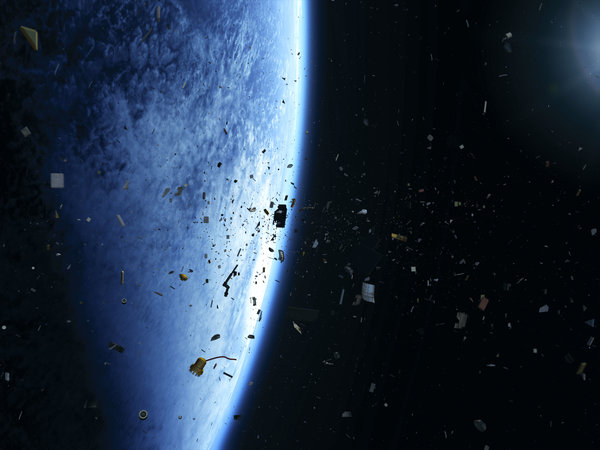The junkyard above your head
Leaving the atmosphere in a rocket is like playing a game of Russian roulette. If you’re lucky, you’ll make it through all the space debris in once piece, but there’s an increasing risk of a fatal collision with a hypervelocity impact. Fortunately, we now have a code of conduct.
Every year, space agency ESA publishes an overview of space junk. By the end of 2017 there were 19,894 pieces of debris measuring 10 centimetres or more. Their total weight is 8,135 tons – more than the Eiffel Tower.
A series of incidents demonstrates this is beginning to take its toll. The examples just roll off Ron Noomen’s tongue (Aerospace Engineering). In 2009, two satellites collided at 42,000 km/h. An hour later, the Iridium-33 and Kosmos satellites were reduced to two massive clouds of space debris. Collisions on satellites’ solar panels are more the rule than the exception, and the Space Shuttle has also been hit – micrometeorites regularly left pits in the cockpit window.
‘It’s a guideline for decent people’
“I think space debris is the number one problem for space technology,” says Noomen. Launches, collisions and exploding batteries contribute to an exponentially increasing amount of debris surrounding the earth. It is quite conceivable that a surge in collisions could create a layer of debris in a low Earth orbit that is virtually impenetrable, resulting in extremely high risks and, in theory, even having major implications for space travel. This worst-case scenario is known as the Kessler syndrome, named after NASA scientist Donald Kessler, who conceived it in 1978.
How long objects continue to orbit the earth depends on their altitude. Up to an altitude of 800 kilometres, the atmosphere will have an effect; satellites and debris will slow down over the course of decades and eventually (largely) burn up in the atmosphere.
Rules of conduct
Space junk has been put on the agenda of the European Union and the United Nations’ Office for Outer Space Affairs. For example, rules of conduct stipulate that new satellites must be 'cleaned up' within 25 years after the end of the mission. In practice, this means that when a satellite is down to its last fuel reserves, it is sent to a low orbit, at maybe 200 kilometres, to slow down and burn up. Small satellites such as the cubesats often don’t carry a motor, and should therefore only be released at a low altitude to prevent them becoming part of the floating junkyard.
“It's a guideline for decent people,” reflects Noomen. “Sanctions aren’t dished out to countries that fail to stick to it.” He goes on to mention a Chinese stunt from 2007. With the rest of the world looking on in astonishment, the new space power pulverised its own satellite to demonstrate the advanced state of its space technology. But also just because it could. Last spring, India pulled the same stunt.
Nevertheless, Noomen expects the amount of space junk to keep increasing. Until now, it was only possible to detect pieces bigger than 10 centimetres. New technology has reduced this to three, and it makes us painfully aware of the fact that we humans leave our traces everywhere, even hundreds of kilometres above our heads.
